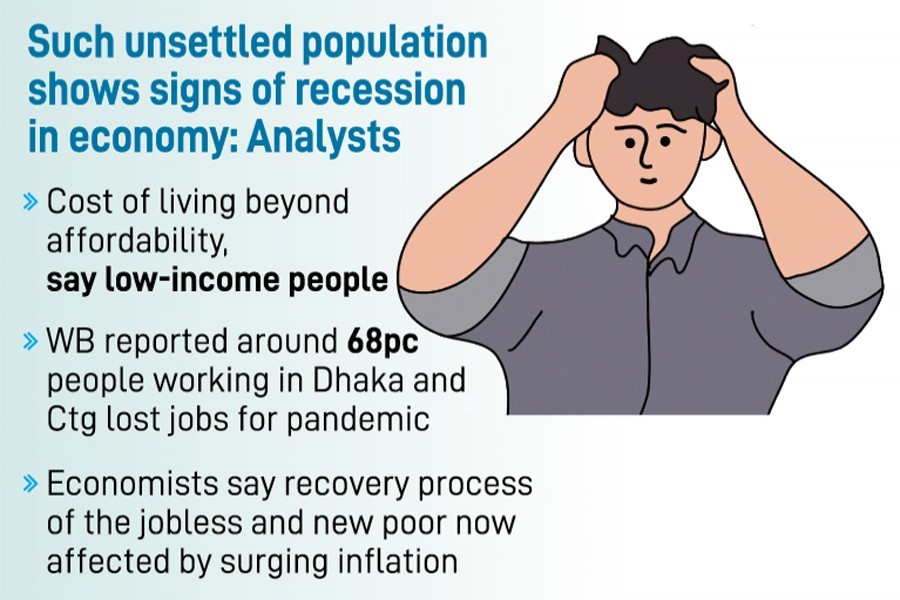Impact of inflation on economy: Part V
Returnees from reverse migration on repeat exodus

Published :
Updated :

Gruelling inflation now forces a section of low-income people either to go back to villages or shift their family members as a coping strategy, in a repeat of the corona-driven reverse migration.
Some analysts see signs of recession in the economy for such twists as these people used to man different segments of economic activities or indispensable odd jobs.
Talking to the FE, low- and middle-income people said the cost of living in the capital city became beyond their affordability amid random price rises with almost no control.
A common phenomenon of urbanization is rural-to-urban migration, but the pandemic Covid upended the normal process of social evolution. The corona-induced economic shocks and resultant all-encompassing inflation, at home and abroad, had forced a vast majority onto reverse migration.
According to government data, inflation climbed up to 7.48 per cent in July from 5.36 per cent in the corresponding month last year. Food inflation also peaked at 8.19 per cent.
Several case studies have shown the proof of the reverse migration in Bangladesh as government and philanthropic assistance proved to be a peanut to help them sustain amid harrowing periods of home quarantine.
However, urban experts say such reverse migration is temporary but those restless floating people are a sign of an upcoming economic recession.
Tenants of the small houses, tin-shed structures and some small apartments said they were compelled to surrender the city life for surging house rents, transportation and other living costs.
Owners of several small houses, ranging between 600 square feet and 800sqf, also acknowledged many of their tenants left during the COVID-19 pandemic and those who came back again started sending back their family members.
Or else, in a deplorable development, many of those trying to stay in cities--particularly poor women and elderly men-- have to take recourse to seek alms from those who appear well-off.
Mizanur Rahman came to Dhaka 15 years ago from his village Panchani, located in the Chandpur district. He was an accountant in a travel agency in Shamoly. During the pandemic, the travel agency could not continue its business and, eventually, Mr Rahman lost his job in January 2021.
Thereafter, he struggled to manage to make two ends meet through two part-time temporary jobs. Finally, he gives up. He now plans to go back to the village as income from a part-time job is insufficient to manage the growing living cost of his family.
"I have a plan to involve myself in agricultural work. Some of my friends also encouraged me to do so," Mr Rahman, now 47, told the FE correspondent.
The FE scribe has found many in the young generation also opting to procure agro-products directly from the farmers and sell across the country as a vocation in the last resort.
Co-founder and Chief Executive Officer (CEO) of Bdjobs.com AKM Fahim Masroor say many fresh graduates are choosing agriculture as their career in recent times--giving farming a modern, innovative look.
Md Adel Islam, aged 35, quit his bank job and started the online business 'Gayer Shaad.'
"I directly collect grocery products from villages and sell those in the city," says Adel, who served Eastern Bank and Standard Chartered Bank earlier.
Some of his friends also had quit Dhaka city and settled in Cumilla and Bandarban to take up agro-based professions, he adds.
Decentralisation could be possible if market access for agro-products could be ensured properly.
In Bangladesh, the agricultural sector generates 38.58 per cent of employment against the global average rate of 26.86 per cent.
However, urban designer Iqbal Habib considers reverse migration an indication of economic recession.
"It is a symptom of global recession like 1974. These people are compelled to quit city life who once came in search of food or work," he says.
Such floating people would not be able to stay in villages, too, for long as the government could not ensure necessary facilities including health and education there, he notes.
The reverse migration is temporary and they will again come to the city searching for work or food, he adds.
A report of Bangladesh Sample Vital Statistics of the Bangladesh Bureau of Statistics (BBS) reveals around 37.4 people per 1,000 had entered the urban areas in 2020, compared to the 36.4 people who had left among every 1,000.
In 2019, outward urban migration was 114.5 people per 1,000 compared to 117.1 inbound migration per 1,000 people. Rural areas saw a higher rate of outward migration of 39.1 per 1,000 than inward migration of 36.5 per 1,000 in 2019, as expected.
Dhaka division has witnessed the highest number of outward migrations.
In 2020, some 69.2 people per 1,000 migrated to rural areas in comparison with the 68.8 per 1,000 migration into urban areas.
In March 2021, South Asian Network on Economic Modelling (SANEM) survey findings showed around 49 per cent of pandemic-hit internal migrants returned to their roots in 2020 due to massive job cuts, non-payment of wages and decreased salaries.
On June 2022, a study by the Power and Participation Research Centre (PPRC) and the BRAC Institute of Governance and Development (BIGD), said the number of new poor in the country stood at 30.9 million, which is 18.54 per cent of the population.
A World Bank report says around 68 per cent of the people who were working in Bangladesh's urban areas of Dhaka and Chittagong have lost their jobs due to the coronavirus pandemic.
Experts and economists say the recovery process of those jobless and new poor is now hit hard due to surging inflationary pressure forcing low-income groups of people to desert cities once more.


 For all latest news, follow The Financial Express Google News channel.
For all latest news, follow The Financial Express Google News channel.